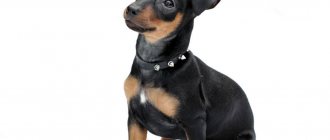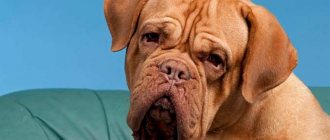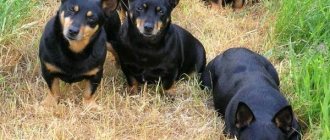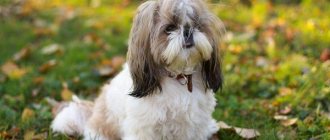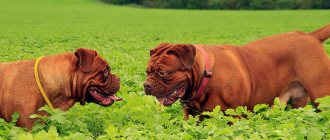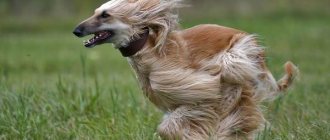Toy poodles look very cute and touching. These are cheerful, affectionate and loyal dogs that love to play and are distinguished by their intelligence and intelligence. All these qualities make them popular pets.
But people who decide to buy a toy poodle need to know not only about the positive qualities, but also about the disadvantages of this breed. And the poodle, like any other dog, of course, has them.
It would also be a good idea for future owners of toy poodles to find out who is better suited as a pet: a boy or a girl of this breed?
Description and features
The Miniature Poodle breed is the smallest of all poodles. She was bred from a larger representative of the breed (the Great Royal). It differs from other brethren not only in its miniature size, but also in the presence of a fluffy curly coat.
It is believed that the dog was born in the 40s of the 19th century. The main breeder of this breed was a Swiss named Shaitlin. Even then he claimed that he had created perfection. In his opinion, the baby poodle is the most loyal, intelligent and noble in comparison with all known dog breeds.
This dog has a huge amount of talent! For example, due to his amazing artistry, he is trained by circus trainers to perform in the arena. The kid loves it when hundreds of people look at him and applaud. For their sake, he is ready to study and train a lot. Even the most difficult tricks will not scare him. Loves attention from the crowd!
Miniature Poodles are easy to train and perform well.
This amazing and kind dog is suitable for almost everyone. Suitable for indoor use, does not cause many difficulties in care. He sincerely loves people and does not seek to create problems for them. He will get along with a pensioner, a schoolchild and even a formidable hunter. She is ready to share her life with someone who will open up to her and begin to patronize her.
The main feature of the animal is its impressive appearance. It is often started to impress others or to show off to neighbors. But you shouldn't do that! Remember, a pet is a living creature that needs your care and love. By buying it, you accept responsibility for its life and health.
The dog is perfect for those who like to attend show exhibitions. With high-quality representatives of this breed, you will be welcomed at any animal event. He will be registered as a participant without any problems. It is possible that it will take a prize place and generate income.
Of course, the animal will never understand the value of money, but will try to win in order to win as many human hearts as possible. Yes, it just loves attention. Despite their kindness and balance, toy poodles have aristocracy and grace. Their gait is cheerful and at the same time majestic, and their gaze is friendly and inspiring respect.
Poodles were previously used for hunting
Breeding history
The first detailed description of the breed was already in the 16th century. Poodles were bred in three countries: Germany, Hungary and France. Large and medium-sized specimens were bred by crossing Barbets, Pulis and Commanders, and dwarf ones inherited the features of Bichons, Toy Spaniels and Maltese. Images of poodles from minted coins from the heyday of Ancient Rome and medieval bas-reliefs have been perfectly preserved to this day. This indicates that this breed is one of the most ancient.
Poodles became truly popular only in the 18th century, becoming favorites of the French nobility. The same period also saw the heyday of grooming, so even then poodles wore elaborate haircuts. The unusual appearance of the animals immediately attracted the attention of representatives of the creative elite. At the end of the 19th century, the Germans issued a breed standard, which European breeders used for a long time.
In 1936 they were replaced by standards developed by the French. Poodles appeared on Russian territory in the 19th century and are still popular today. These animals never tire of demonstrating their wonderful character, intelligence and artistry in the circus arena, giving a good mood.
Breed standard
The toy poodle dog is small in size and weight. It was created with almost complete preservation of the parameters of the “standard”, that is, the large royal poodle. Despite its cute appearance, this dog has a lot of strength. He is agile, resilient and very nimble.
The body of the dwarf poodle is compact and harmonious. Weighs from 4.5 to 5.5 kg. The body weight of some representatives of the breed is in the range of 3.5-3.9 kg. They are also considered purebreds, but are much more expensive because they are born extremely rarely.
The height of the dog is from 27 to 33 cm. Errors are allowed. The shape of the body is rectangular, it is strong and elegant, slightly oblong. The back is shortened, and its narrowing is visible in the croup area. The lumbar region is well defined. The chest is oval, wide, and does not protrude.
The representative of the breed is very graceful, primarily due to the well-tucked up belly. His silhouette is graceful, clearly defined, not blurry.
The tail is straight, located high on the back. According to the standard it can be cropped. But individuals whose owners do not plan to register at show events do not need to have their tail docked; it will not become a hindrance to them at all. The limbs are set straight and symmetrically. The rear ones are wider apart than the front ones. The muscles on the thighs are strong and elastic.
The dog has a slightly elongated neck. The withers are well defined, the scruff of the neck is visible and palpable. The head is harmonious and has the correct shape. Very smooth transition from muzzle to forehead. Slightly elongated skull with a barely convex occipital protuberance. The muzzle is miniature. The jaw is powerful, the set of teeth is complete.
The ears are set low, in line with the eyes. Large, thick, hanging down. Covered with hair along the entire length. The lips are pressed tightly to the teeth, moderately moist. Has black pigmentation. A dark gum line can be seen along the entire length of the mouth. There may be pinkish spots of varying diameters on the oral folds.
The nose is large and black. The nostrils are wide. The eyes are dark, black or brown. The shape is oval, not planted deep. The miniature poodle in the photo looks like a big toy. He is sweet, handsome and charming. The coat is long, lush and curly. The shortest hairs are about 20 cm long. They are delicate to the touch. They cut their hair well.
Acceptable color options for poodles:
- Pure white.
- Pure black.
- Silver or blue.
- Brownish.
- Apricot.
In Russia, individuals with a hint of harlequin fur are often found. They are standardized only here.
General form
The dog has an elongated “fox” muzzle, a large dark nose and narrow-set dark, almost black almond-shaped eyes (as well as the presence of amber highlights in apricot-colored dogs). The ears hang down, widen greatly towards the bottom and are rounded at the ends, flat. The body is proportional, strong straight legs with well-developed muscles, good posture with a high-set graceful head. The paws are small, with neat pads.
They come in a wide variety of colors, so it's hard to choose just one! These colors range from white, grey, brown, cream and other shades. However, the most popular are the red toy poodle and the black toy poodle.
As for their fur, there is practically no shedding as such - this is surprising for people suffering from allergies. However, their coat requires more time and effort to groom than other dog breeds. Without proper care, their coat is prone to matting, which can contribute to the development of certain infections. Toy Poodles should be groomed every 4-6 weeks.
Character
The life position of the dwarf poodle is very active. This is not the kind of dog that will sleep peacefully at the front door during the day. How can he rest when so many interesting things are happening in the world? The dog rarely gets tired in the first half of the day, even if he moves a lot. This is due, first of all, to its excellent endurance.
She loves entertainment and fun games. Prefers to spend time with its owners. But he can keep himself busy on his own, especially if he has bright toys at his disposal.
Note! The Poodle is one of the most social dog breeds. He loves to communicate with animals and people, and is afraid of loneliness like fire. Never leave him alone for a long time.
All poodles, without exception, are naturally curious. They never sit still, especially in the morning. They run after the owner, play, watch other pets, etc. They sleep mainly at night.
Very smart. Not prone to laziness. A well-mannered representative of the breed understands his owner perfectly. Easily and quickly absorbs information and remembers commands. Capable of empathy and compassion. Treats owners tenderly. He gets along well with children, especially if they are friendly to him.
A little intrusive, but out of harm, but out of the need to always feel human love. Vulnerable and tremulous by nature. A good companion. Prefers to spend time with family rather than alone.
Important! If your toy poodle is withdrawing from you and sleeping a lot, he may be sick. This behavior is not typical for healthy representatives of this breed.
Such a mischievous dog has one significant drawback - severe jealousy. The owner is extremely important to him. Without it, he loses self-sufficiency and becomes vulnerable. In great need of care and love. When he sees that the owner is giving attention to someone else, he suffers greatly. He may even bite in retaliation. Prone to offense, but not vindictive.
Prefers to be in human rather than animal company. The owner has a negative attitude towards other pets. He doesn't like it when household members pay attention to other pets. It cannot be used as a house watchman, as it is peaceful in nature.
Wariness and suspicion are not characteristic of poodles, so they warmly welcome every guest, but are not polite to everyone. These dogs are selective in social contacts; they are not friendly to every stranger. Representatives of the breed make friends with kind and cheerful people, as they find similarities with them.
Quite fearful. May be frightened by a loud sound, a suspicious person or a bully dog. At this moment, it is better to pick him up and calm him down. You should not scold your pet for a strong display of emotions. He is impressionable and vulnerable by nature.
Miniature Poodles have an easy-going, friendly personality.
Care and maintenance
Poodles move around a lot during the day. These are very energetic creatures that need long walks. You can live with them not only in a house, but also in an apartment, the main thing is to go out into the fresh air more often. The ideal option for relaxing with such a pet is in nature. He loves to run in the forest, especially when the weather is sunny, swim in water, but not deep, bring a ball to the owner, etc.
Therefore, when going on an outing with friends, do not forget to take your dog with you! You will have to bathe your fluffy dog often. Fortunately, he enjoys this procedure, so he does not resist when he finds himself in a full bathtub. When shampooing your animal, be careful not to let any water get into its ears.
Gently rinse his eyes. Lather each paw, making sure to thoroughly clean out any dirt between the pads. In addition to the main detergent, shampoo, we recommend using animal conditioner. At the end of the procedure, the dog should be thoroughly dried with a towel.
If you wash it in winter, especially in a cool apartment, it is better to dry it additionally with a hairdryer. Otherwise, he may catch a cold. After these manipulations, the dog should be combed with a comb. It is important to “walk” it all over her body, paying special attention to the area under the ears.
Important ! The Miniature Poodle is perfect for dog owners with allergies. It has hypoallergenic wool, which, moreover, does not shed at all.
If you notice that your dog's fur is coughing or matted, we recommend using a spray bottle to spray moisture on it and then combing it. Her fur grows very quickly, so she will have to resort to the services of a groomer often, every 3-4 weeks. We do not recommend cutting such an animal yourself.
Poodle ears require special care. They are washed out of sulfur very carefully so as not to injure the delicate skin near the canals. If excess moisture gets into the ears, inflammation cannot be avoided.
Known health problems
Most Toy Poodles live long and healthy lives on average due to responsible breeders and owners. However, there are some health problems they may be susceptible to:
• Progressive retinal atrophy (PRA)
Progressive retinal atrophy is a degenerative condition that causes the retina at the back of the eye to gradually deteriorate. This eventually leads to vision loss. Progressive retinal atrophy can be acquired due to normal old age. But it can also be caused by faulty genes that are inherited through some Toy Poodle breeding lines. Fortunately, the faulty gene and carriers can be identified using a direct and readily available DNA test.
• Cataract
A huge retrospective study of dogs diagnosed with cataracts between 1964 and 2003 found that just over 10% of toy poodles have cataracts, compared to 3% in the general canine population. This probably indicates the existence of a genetic connection between the Toy Poodle breed and cataract disease. However, unlike progressive retinal atrophy, there is no definitive DNA test to identify dogs at risk. So, to check for cataracts, all breeding poodles must have had a full eye examination by a specialized veterinary ophthalmologist within the last year.
• Patella dislocation
A luxating kneecap is a deficiency in the knee joint that allows the top of the tibia to slip in and out of place, causing lameness. Patellar luxation is a problem in many small dog breeds, including toy poodles. There are varying degrees of this pathology, depending on whether it was present from birth or developed in adulthood, and how severely it affects the dog. Toy poodles that are used for breeding must have certificates issued by the Animal Orthopedic Foundation describing the condition of their knee joints.
• Von Willebrand's disease
Von Willebrand disease, more commonly shortened to VWD, is an inherited blood disorder. Dogs (and people) with vWD do not produce enough of a protein in their blood plasma called von Willebrand factor (vWF). vWF plays an important role in blood clotting during skin trauma. Dogs with vWD are prone to nosebleeds and bleeding gums, as well as excessively bleeding cuts or wounds on the skin. This condition is caused by a mutation in the gene that normally codes for vWF. This means that toy poodle puppies that carry the gene can inherit it. Fortunately, a DNA test for von Willebrand disease is readily available. When you choose a Toy Poodle puppy, their breeder should be able to show you certificates to confirm that neither parent carries the vWD mutation.
• Thyroid problems
In general, all poodles are vulnerable to thyroid problems. This is a fairly superficial definition that can cover a wide range of conditions and symptoms. These may include lethargy, weight gain, digestive problems, oily skin, dry skin or skin infections, hair or undercoat loss, oily coat, and more. When looking for a Toy Poodle puppy, ask the breeder if any of the dogs in the puppy's family tree have been diagnosed with thyroid problems.
Nutrition
Poodles are real gobblers. They behave as intrusively as possible when they see food in the hands of household members or their guests. They can make the cutest face in order to beg for a piece. Remember, you cannot feed purebred dogs from your table! Their stomach is not able to digest every product.
Miniature Poodle puppies should eat:
- Lean meat (turkey, veal, beef, chicken).
- Lean fish. It is important to clean it before giving it to your dog.
- Chicken eggs.
- Boiled porridge.
- Soups.
- Kefir or milk.
- Hard cheese and cottage cheese.
In addition to water, they should drink milk. You can boil it first. Your pets should always have access to clean drinking water. At 6 months of age, the baby can be gradually transferred to another product - wet or dry food. We recommend adding a small amount of the product to a bowl of porridge or soup. This will allow you to quickly get used to the change in diet.
Reproduction and lifespan
The miniature poodle has joined the ranks of long-lived dogs. With proper nutrition and good care, he will live at least 15-16 years. The breeder must be able to distinguish a miniature poodle from a toy. They are very similar, but still different. It is advisable to breed individuals of the same breed species. It is important that they are not related to each other, since in this case they will not have to wait for healthy offspring.
It is necessary to count the date favorable for conceiving offspring and take the bitch to the male on the 3rd day of her heat. She gives birth to from 1 to 6 puppies. Childbirth can be complicated, so when she starts having contractions, we recommend calling a veterinarian.
How to choose a puppy
If the dog does not have a pedigree, there is a risk that a medium-sized poodle will be purchased, which is slightly larger than a toy. Externally, the puppy should be active, strong, with clean eyes and nose. The animal should not show signs of diarrhea or fleas. If the belly is very swollen, then this is a sign of intestinal diseases or worms, and it is not advisable to buy such a dog. A good puppy should not be much larger in size than the rest of the litter and should not be the smallest in it.
When choosing a puppy, you should not give in to feelings of pity. It forces you to buy the smallest, seemingly downtrodden puppy, who shuns his brothers and sisters. However, this is not the best solution, since in the future the owner will face constant treatment for various diseases, and the animal’s life expectancy will be lower.
Price
Only the breeder from the nursery will provide you with a guarantee that the dog fully complies with the accepted international standard. Therefore, if you would like to take your pet to show exhibitions in the future, be sure to purchase a pedigree for it.
The price of a miniature poodle with documents from the nursery is from 7 to 15 thousand rubles. Some breeders artificially inflate the cost of these dogs, selling them for more than 30 thousand rubles. We do not recommend working with them!
Training
Poodles are the best breed to train. Thanks to their intelligence, intelligence and obedience, they were able to make excellent street performers. During training, you cannot behave rudely with the dog, otherwise it will get angry and you will not be able to achieve a positive result. Do not skimp on praise and encouragement. Poodles especially love to jump over obstacles, dance to music and catch balls.
The Miniature Poodle is an amazing breed of dog. A true artist, a restless trickster and a brave hero - he will win the heart of anyone, become a reliable friend, companion and partner who will understand perfectly.
Raising and socializing a dog
The poodle is a very artistic breed, so it is recommended to organize its training process like a circus performance. He is a born artist, so he needs spectators and encouragement. If you want to teach him simple commands, invite your household members to sit next to him and watch the process. Let them clap their hands every time the dog has completed the task. This is a great training method!
To teach such a pet complex acrobatic tricks as quickly as possible, walk him often. Yes, having gained new emotions and vivid impressions, he will try to earn approval. Don't forget that poodles are one of the smartest dogs that can be taught to do almost anything, for example, they can fetch slippers for their owners or carry their own leash.
By the way, about walking. Representatives of the breed love to walk in different places, and for quite a long time. But this does not mean that they can be indulged in everything. They should not pull on the leash. But, if this does happen, we recommend taking action. Pull your pets firmly and stop from time to time. This way they will quickly learn to understand that a person is in control of the walk.
Some tips for home socializing your toy poodle:
- Don't leave him alone, locked in a room. This dog doesn't like to be alone.
- Be there when he meets your other pets. The dog should understand that you are protecting him and, if something happens, will protect him.
- If another dog notices your pet while walking, pick it up.
Poodles have good health and are long-lived.
You should teach him as early as possible, firstly, to respond to a nickname, secondly, to go to the toilet on the street, and not in the house, and thirdly, to treat each family member with respect. Reprimand an animal if it barks for no reason, shows aggression towards anyone, or refuses to obey.
Nicknames
A dog's nickname is chosen for its entire life. It should be sonorous, but at the same time simple, so that the animal can easily remember it.
| For boys | For girls |
| Henri | Adele |
| Athos | Anetta |
| Bruno | Valerie |
| Georges | Julie |
| Leon | Georgette |
| Marseilles | Katrina |
| Samson | Margot |
| Thierry | Nicole |
| Javier | Helen |
| Etienne | Ellie |
Possible diseases and methods of treating them
Unfortunately, representatives of this breed are sickly. Doctors discover cataracts or otitis media in almost every poodle at the end of its life. Genetically, such dogs are predisposed to many eye and ear diseases. They cannot be treated without professional help.
Also common among them are: hip dysplasia, osteochondrosis, diabetes mellitus and other diseases. In dogs that suffer from ailments of the joints and muscles, coordination of movements is impaired. They should not be exhausted by stress; it is better to create comfortable conditions for home rest.
But those who are faced with diabetes or allergies will have to follow a diet. Less commonly, toy poodles are diagnosed with cancer. If malignant tumors are detected early on the surface of dog organs, it is possible to save them in an operable manner.

